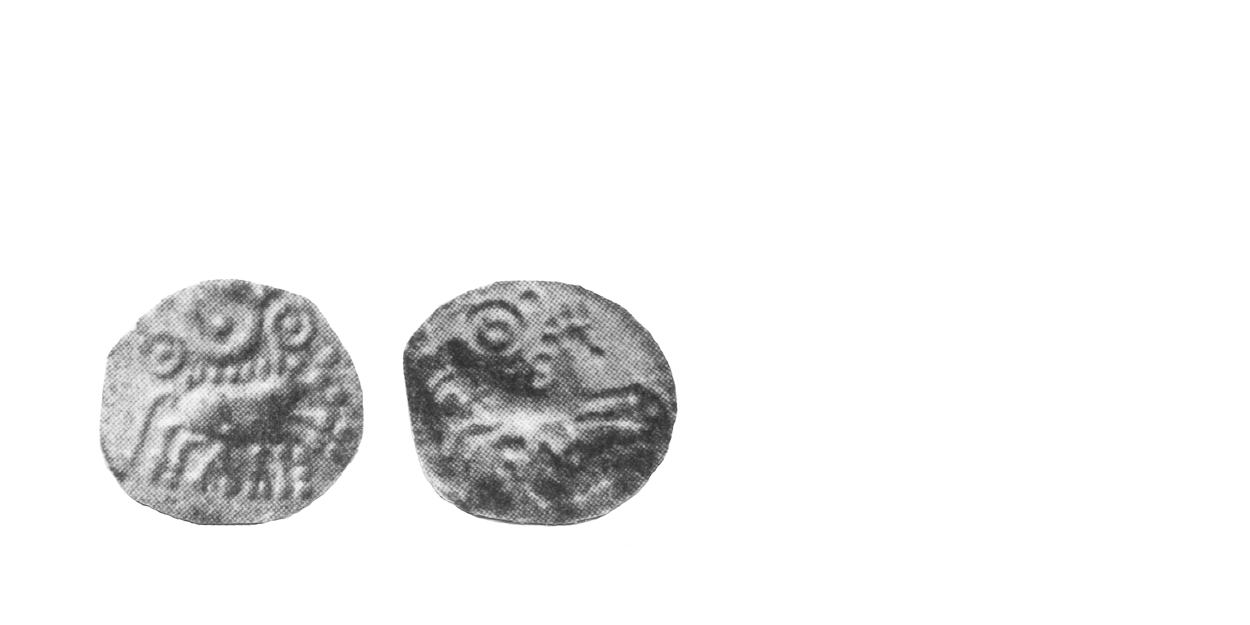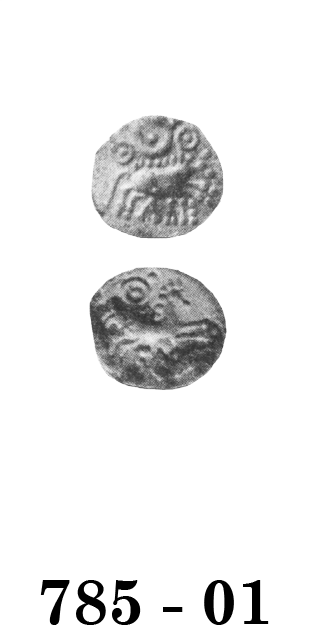
Celtic Coinage of Britain
third edition
Click on coin to see hidden information
Uncertain Coins Inscribed "ALE SCA"
The first coin of this type was discovered during archaeological excavations at Caister St. Edmunds in 1929. Consequently, the type is almost certainly genuine. However, the excavator described it as "British Icenian unrecorded variety, base silver". The coin was not illustrated in the excavation report. It remained described this way until 1940, when Clark grouped it with three other Icenian coins found at the site, thereby misattributing it. In 1963, Derek Allen corrected the error by publishing it as a new type either Corieltauvian or possibly Icenian. Allen also reported the appearance of a second example in his 1963 report.
Today, the Caister St. Edmund find remains the best evidence to place the issue in Icenian territory. In 2011, John Talbot suggested the type should be assigned to the Iceni. The listing here follows that attribution. No dating evidence exists, the dates given here are provisional, at best. Generally, the type is thought to be late, perhaps contemporary with the ECEN series.
In the 1980's, modern forgeries were seen and a cautionary note was added to the 1989 catalogue listing. The fake coins have not yet been published and the cautionary note remains in place.
Since 2000, coins of a new, but similar type have appeared every few years. They all appear to be struck from the same dies and records suggest they may have a common find source. The inscription is difficult to interpret, but "ALIFF SCAVO" would be a one reasonable reading. The image of the boar is peculiar and the lettering arrangement on these coins is unusual. Although the tendency has been to lump these new coins with the traditional ALE SCA type, no such association should be assumed. The new type should be viewed as a separate issue, possibly one with a different dating.
Icenian Dynastic Coinages
At the end of the uninscribed coinages, an enigmatic coin appeared with the inscription CANI DURO. This may have been a local issue, or alternatively, the start of the dynastic issues.
The first certain dynastic issues start with the inscription ANTED, about 20 A.D. It is difficult to explain why the Iceni failed to inscribe their coins prior to this, possibly the Trinovantes/Catuvellauni exercised some influence over the tribe to prevent it. The coinage included a very small issue of gold staters and a large issue of silver units and fractions. ANTED is thought to be a personal name, or less likely, a title of a ruler.
Later, possibly around 35 A.D., coins inscribed ECEN appear. Again a very small issue of gold staters is accompanied with a large issue of silver units and fractions. ECEN is traditionally thought to be the name of the tribe, but is possibly the title or epithet of a ruler, instead.
Coins inscribed SAENV, AESV and ESV PRASTO ESICO FECIT appear at an uncertain date around the time of the ECEN coinage. Traditionally, the SUB ESVPRASTO coin was attributed to Prasutagus, but the interpretation has become much more complicated since 2000. The most recent thinking is that these three types are all somehow related.
A final group of uninscribed silver units starts sometime towards the end of the ECEN series and probably continues after the Claudian invasion. The very last of these coins are known only from the hoards of the Boudiccan Rebellion. These final types represent the coinage of Queen Boudicca, struck to finance the Icenian revolt of 61 A. D.

785 - 01 ALE SCA
20-43 A.D. Extremely Rare
Silver Unit ca. 1.8 gms. 15 mm
Earliest Record: Atkinson, 1929
OBV: Boar right
Identifying points:
- crescent-with-pellet motif above boar, with two smaller pellet-in-ring motifs on either side
- ALE below boar, no crossbar on letter "A"
REV: Celticized horse right
Identifying points:
- pellet-in-ring motif above horse
- SCA below horse, no crossbar on letter 'A'
CLASSIFICATION: Icenian P
NOTES:
- First example found during excavations at Caister St. Edmunds in 1929; consequently the type is almost certainly genuine
- Originally, this type was listed as an uncertain Corieltauvian issue (996 - 01) with cautions that it might be an Icenian issue instead
- Modern forgeries reported in the 1980s make rarity estimates problematic
The Coinage of the Iceni
The Iceni occupied the area that is today Norfolk, Suffolk and parts of Cambridgeshire. Until the time of the Gallic War, the tribe seems economically isolated. Large Flan, Defaced Die and Abstract Design Type staters are not commonly found in Icenian territory, and presumably few were imported. Locally-made coins, the NORFOLK WOLF TYPE staters and BURY TYPE silver, were first produced late in the Gallic War. The earliest Icenian gold coinage comprises gold staters with the abstracted head of Apollo on the obverse and a disjointed wolf on the reverse. The heavy weight indicates the series began some time around the end of the war. After the war, the coins become quite debased and bronze cores of plated staters occur with some frequency. Later, a small coinage of SNETTISHAM TYPE coins were struck in gold and silver.
Apparently, extensive trading contacts developed during the war with the Trinovantes/Catuvellauni. A small number of Gallic War Type staters are found and uninscribed staters of the Trinovantes/Catuvellauni also appear. After the war, the coins of Addedomaros and Tasciovanus circulated. It is possible the Iceni relied on these imports instead of striking their own gold in volume.
About 20 B.C., the gold content of the Icenian coinage was restored with the introduction of the FRECKENHAM TYPE. Staters and quarters were struck lighter in weight to conform with the coinages of the other British tribes. The staters had a flower pattern or cross of pellets on the obverse and a Celticized horse on the reverse. Three major types occurred, described either as EARLIER and LATER, based on style and the progressive damage to one particular die linked with several others. Since all three types occurred in the Freckenham Hoard, it is likely they were contemporary.
After the war an extensive Icenian silver coinage was produced, which probably continued up to the time of the Boudiccan Rebellion. Silver units were produced to a standard weight of 1.25g. for nearly 100 years, a remarkable economic and technological achievement. There was a bewildering succession of types, subtypes and minor die varieties. These varieties have been systematically analyzed by John Talbot, and the arrangement is now reasonably certain. It appears that in any given period, three separate kinds of silver were being struck. Talbot suggests that the main Icenian mint either had two branch mints, or alternatively three workshops within a single mint. It is also possible that the different kinds of silver were either produced for different purposes, or perhaps at different times within a given period. Generally, the absolute chronology needs additional work. The chronology used here makes use of the work reported in John Talbot and Ian Leins's 2010 paper in The British Numismatic Journal.
The FRECKENHAM TYPE disappeared by 20 A.D. and the uninscribed silver coins were superseded by the dynastic. Very few inscribed gold coins are known. It is possible the gold coinage was minimal and the Iceni used silver coins augmented with Trinovantian/Catuvellaunian gold after 20 A.D. The Icenian dynastic period is largely one of a prolific silver coinage, beginning with the addition of an inscriptions to the CRESCENT TYPE and the introduction of the EMBLEM TYPE.
